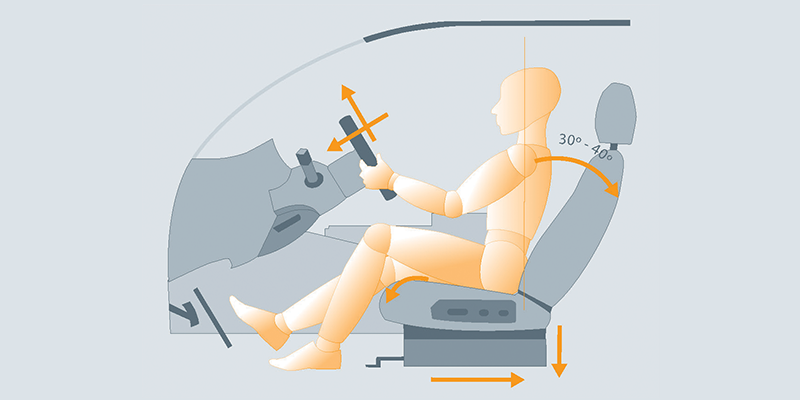Top 10 tips from our driver training experts

Whether you are an experienced driver, teaching a learner, or managing a fleet, take advice from Darrin Tucker, our Driver Training expert, and make sure you know these top tips to remain a safe driver on the Australian roads.
Instill Low Risk Driving strategies
It’s important drivers know how to be safe on the road and by teaching Low Risk Driving strategies, we can help everyone get where they are going safely.
Some basic but important Low Risk Driving strategies can include setting up for hazards, 3 second following distance and personal management of fatigue.
Low Risk Driving will significantly reduce the risk of the most common crashes, as well as reduce maintenance and fuel costs.
Make sure driver training is up to date and your drivers know the latest road rules
NSW drivers are expected to pass a driving test when they qualify for a driver's licence and no other training or assessment is needed for just shy of 70 years.
A lot can change in that time, from road rules to vehicle technology, and strategies to ensure the safety of everyone in your business or workplace.
Make sure your drivers are always up-to-date and their training is current. The NRMA can help you with this with our driver training for business programs.
Employees should be aware of the businesses driving policies
What gets measured, gets done. Your company's driver policy should form part of the workplace safety culture.
Keep your driving policies ready and available for all staff. Consider having the policy available online, included in contracts, and a copy kept in each vehicle.
You can ensure employees are aware and stay up to date with the policy by doing refresher courses or eLearning at regular intervals.
Set realistic timeframes for your drivers
It's time to reframe the age-old adage “time is money." While this may apply to your business it, should not apply to the road. Ensure your drivers are not feeling pressured to drive in an unsafe manner, such as speeding or tailgating.
A driver who feels comfortable and not stressed will anticipate and be proactive when reacting to hazards on the road.
Ensure your staff are confident to drive work vehicles
Business vehicles come in all different shapes and sizes. So when expecting staff to drive new vehicles, make sure they have been trained or had sufficient practice before a long or solo journey.
For example, driving a van with limited rear vision is very different to driving a sedan or hatchback.
In most passenger vehicles the driver is sitting right between the front and rear wheels, but in a van or light truck, the driver is sitting towards the front of the vehicle, which is a very different perspective. This type of awareness for your drivers can have a big impact on your insurance and vehicle repair costs. The right training can make a big different to insurance premiums and downtime.
If your drivers are confident in the vehicle they're in, they'll be more efficient and the risk of minor or major incidents may be reduced.
Employees should be completing a visual check of the vehicle before driving
Just like when hiring a car, employees should complete a visual check of the vehicle before setting off on their trip.
This becomes especially important when the vehicle is shared by multiple drivers. It’s possible there may be damage to the vehicle that hasn’t been reported, the tyres may be worn or a chip in the windscreen may have gone unnoticed. It’s important that the current driver is aware of these.
Consider having a printed or online checklist for the driver to complete.
Ensure driver ergonomics are set for excellent posture, comfort, vision and safety
For vehicles that are shared, it’s important each driver is comfortable before hitting the road.
Take the time to adjust the following to ensure a comfortable drive:
- Adjust the seat base distance and height to ensure adequate vision out of the vehicle and that there is bend in the knee when the brake pedal is applied.
- Seat back rest is adjusted for good posture and comfort
- The middle of the head restraint should be at eye level to the driver, as this is where the skull meets with the spine
- Adjust seat belt, low, flat and firm across collarbone and hip bones
- Adjust the central mirror to frame the rear window perfectly and the side mirrors to eliminate and minimize the blind spots of the driver
- Last adjustment is the steering, for correct distance and height.
Plan out your route
When you’re driving for work, it’s likely you’ll be going to a lot of different places. When driving to a place you’ve never been before, plan the route you’re going to take before setting off, particularly if you're driving a large van or truck.
Make sure any GPS devices are used in a safe and legal way.
Drive more carefully at night
Lack of visibility makes night driving hazardous. Slow down if you're having trouble seeing and in rain. Also, try shifting your gaze slightly away from oncoming headlights onto the fog line along the road and adjust your rear vision mirror to reduce glare from behind.
Drive to the conditions
Rain, wind, glare, gravel and night driving all pose their own unexpected threats. Slow down, always drive within your comfort zone and observe advisory signs on the road; they're there for a purpose. Advisory speed signs on corners allow the driver 5 seconds of vision when rounding this corner.
Driving out of town? Country roads can be narrow, winding, and surprising. Keep an eye out for wandering wildlife – especially during dawn and dusk hours – and drive cautiously when you’re unsure of an area.
Remember to follow advisory signs and even though the road may be quiet, remain alert and drive at the posted speed.



